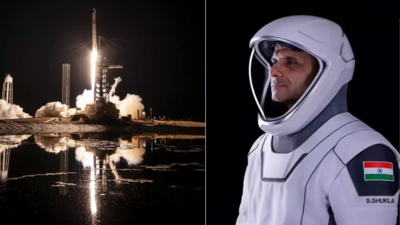India Reaches New Heights as Shukla Enters International Space Station
The International Space Station (ISS) has welcomed its first Indian astronaut, Shubhanshu Shukla, amidst a flurry of excitement.

The Dragon series' fifth spacecraft, Grace, successfully docked with the ISS at 16.01 IST on Thursday, while flying over the North Atlantic Ocean.
Shukla becomes only the second Indian to venture into space, following Rakesh Sharma's historic 1984 flight. He is joined on the Axiom-4 mission by Slawosz Uznanski-Wisniewski, marking Poland's return to space since 1978, and Tibor Kapu, Hungary's first astronaut in 45 years. The crew launched from NASA's Kennedy Space Center on Wednesday.
India is rapidly advancing its space capabilities, with ambitious projects on the horizon.
Gaganyaan: India's ambitious indigenous human spaceflight program, Gaganyaan, is slated for launch by 2027. This mission aims to place India among the elite nations—Russia, the United States, and China—that have independently achieved manned space missions.
Shukla's experiments aboard the Axiom-4 mission are specifically designed to provide critical data and support for the Gaganyaan program. His research investigates the effects of microgravity on various factors crucial for long-term space travel, including:
These studies are vital for developing sustainable space food systems, ensuring astronaut well-being, and enhancing life support strategies for future Indian space missions. He is also analyzing tardigrades to gain insights into survival mechanisms in extreme environments.
NISAR Satellite: A joint venture between NASA and ISRO, the $1.5 billion NISAR (NASA-ISRO Synthetic Aperture Radar) satellite is scheduled to launch in July from India's Satish Dhawan Space Centre. This advanced Earth-observing mission utilizes high-precision radar to monitor surface changes around the clock. NISAR will provide essential data for a wide range of applications, including:
Unlike many Earth-observing satellites limited by daylight and weather conditions, NISAR employs advanced radar technology to capture images 24/7, regardless of cloud cover or darkness. This capability ensures more accurate and consistent monitoring of natural disasters, environmental changes, and agricultural trends. NISAR is poised to revolutionize data collection for scientists, farmers, and disaster response teams globally.
Newer articles
Older articles
 Gavaskar Calls for Kuldeep Yadav's Inclusion in Second Test; Questions Bumrah's Fitness After Leeds Loss
Gavaskar Calls for Kuldeep Yadav's Inclusion in Second Test; Questions Bumrah's Fitness After Leeds Loss
 India's Harshit Rana Released from Test Squad Ahead of Second England Clash
India's Harshit Rana Released from Test Squad Ahead of Second England Clash
 Saucecode:
Nitish Rana Eyes Delhi Return After Disappointing Uttar Pradesh Spell
Saucecode:
Nitish Rana Eyes Delhi Return After Disappointing Uttar Pradesh Spell
 ICC Test Rankings: Pant Climbs to Career-Best, Bumrah Holds Top Spot as Root Reigns Supreme
ICC Test Rankings: Pant Climbs to Career-Best, Bumrah Holds Top Spot as Root Reigns Supreme
 India's Fielding Woes Blasted by Ex-Selector After Test Defeat Against England; Calls for Patience Amid Transition
India's Fielding Woes Blasted by Ex-Selector After Test Defeat Against England; Calls for Patience Amid Transition
 Elon Musk’s AI company will make Grok chatbot more accessible, here’s how
Elon Musk’s AI company will make Grok chatbot more accessible, here’s how
 India's Batting Collapses Trigger Debate: Gambhir Defends Lower Order, Cites Missed Catches, Workload Management as Factors in Test Loss
India's Batting Collapses Trigger Debate: Gambhir Defends Lower Order, Cites Missed Catches, Workload Management as Factors in Test Loss
 Bumrah's Birmingham Nets Spell: Accuracy, Angles, and Ambiguity Surround India Spearhead
Bumrah's Birmingham Nets Spell: Accuracy, Angles, and Ambiguity Surround India Spearhead
 IRCTC's AskDisha 2.0: AI Chatbot Streamlines Train Ticket Booking, Refunds, and Information Access
IRCTC's AskDisha 2.0: AI Chatbot Streamlines Train Ticket Booking, Refunds, and Information Access
 Wimbledon 2025: Alcaraz, Sabalenka, Fritz, and Anisimova Advance to Thrilling Semi-Final Showdowns
Wimbledon 2025: Alcaraz, Sabalenka, Fritz, and Anisimova Advance to Thrilling Semi-Final Showdowns